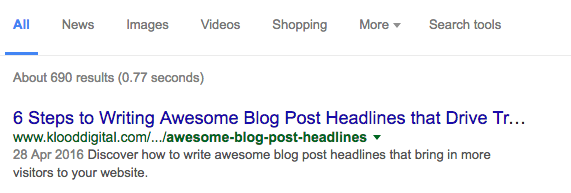What do you think the success of any single blog post relies on most? Is it down to how you structure your post, what images you use or the way you’ve incorporated your call-to-action?
The truth is that, although all of those things are very important, the crucial thing for the success of any blog post is actually getting people to read it, and this metric will live and die by the quality of your headline. After all, it’s the headline that convinces you whether or not to click on that link or not.
However, all too often you’ll see examples of blog post titles where the author simply hasn’t taken the time to craft a headline that is going to encourage clicks.
Read on to discover how you can craft excellent titles that improve user engagement with your blog posts.
Step One: Decide on a working title
Before deciding on a title you should have already identified the topic you want to write about. Your topic might be maintaining a lawn in winter, basic car repairs or even a guide to headline writing.
Your working title differs from the topic in that it is much more specific and guides you while writing the blog. As an example, my working title for this post was ‘How to Write Blog Post Headlines’.
After you’ve finished writing it you can then go back and perfect your title and make sure it accurately reflects the content of the post.
Step Two: Include a relevant keyword
When writing the perfect headline you should be keeping the user at the forefront of your mind, not search engines, but that doesn’t mean you shouldn’t think about the sorts of things your target market are searching for.
Try and include at least one keyword within the headline to give your blog post the best chance of appearing in the search results - but don’t force it.
Step Three: Utilise ‘Power’ words
Power words often entice people to click on a link - the words that can sum up the benefit of a post immediately.Here are some examples of power words to give you an idea:
- Free
- New
- Guaranteed
- Easy
- Results
- Increase
Be sparing with power words as you don’t want to overdo it, but one or two - whenever they’re appropriate - can go a long way to improving click-through-rates.
Step Four: Outline the benefits & set expectations
Power words are great tools for packing a punch to a headline and can be used to demonstrate how the article will benefit the reader, but you need to make sure the whole headline is doing that job for you too.
Your aim should be to leave the reader in no uncertain terms about what the blog post is about and what they will take away from it. At the same time, you don’t want to over-inflate the benefits of reading the post - don’t write cheques your content can’t cash. You might have encouraged more clicks, but once the user is reading your article they’re going to be disgruntled that you haven’t delivered what you promised.
Step Five: Make it engaging
Let’s consider my working title for a moment: ‘How to Write Blog Post Headlines’.
It’s certainly setting the right expectation and, more or less, conveying the benefit to reading it. But are you really keen to click on it? Probably not.
We’ve got our key word in there (“Blog Post Headlines”), but we don’t have any power words in there. That’s our next step.
How to Write Awesome Blog Post Headlines
Well it’s an improvement, but perhaps somewhat superficially. This title isn’t explaining anything else about the benefits of reading the post, other than the fact it will show you how to write ‘awesome’ blog post headlines - but why would that matter?
How to Write Awesome Blog Post Headlines that Drive Traffic
This is much more like it. By mentioning that improved blog post headlines can drive traffic, we’ve managed to go further in explaining the benefits of reading this post.
The ‘How to’ article is a popular one, and would work well for this post, but there’s another option open to us that I think would work better - the ‘listicle’ style.
6 Steps to Writing Awesome Blog Post Headlines that Drive Traffic
By starting the headline with ‘6 Steps’ instead of ‘How to’, you make it that little bit clearer what the reader can expect. What’s more, six steps sounds very easy to digest, rather than the somewhat vague ‘How to’, which for all the reader knows could be 3,000 words and 100 steps!
Step Six: Keep it short
That headline ticks every box except one - it’s too long.
The titles in Google search results are cut off after 60 characters, and that headline is 65, which means it will look like this:
You still get the idea, but the idea of crafting the perfect headline is that you can read the whole thing! With that in mind, we need to find a way to shorten it while keeping the tone the same:
6 Steps to Writing Awesome Article Titles that Drive Traffic
We’ve swapped out our keyphrase ‘blog post headlines’ for one of our other, shorter phrases: ‘article titles’. This now brings the headline in at 60 characters - bang on the limit imposed by Google’s search results.
Don’t let your fantastic blog posts go to waste by letting them down with shoddy headlines. Follow these six simple steps to supercharge your content click through rates.
Stay Updated with Our Latest Insights
Get expert HubSpot tips and integration strategies delivered to your inbox.



